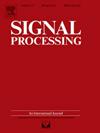Transceiver beamforming design of RIS-aided active array radar in cluttered environments
IF 3.4
2区 工程技术
Q2 ENGINEERING, ELECTRICAL & ELECTRONIC
引用次数: 0
Abstract
This paper equips a reconfigurable intelligent surface (RIS) to assist the active array radar for boosting its interference suppression ability and enhancing the beamforming gain towards target direction simultaneously. The output signal-to-interference-plus-noise ratio (SINR) is chosen as the metric to jointly design the transmit and receive beamformers of radar array and RIS reflection coefficients. In light of SINR performance and implementation complexity, two operation modes using identical or distinct RIS reflection coefficients in transmit and receive stages (ITR or DTR) are investigated. In each mode, the proposed joint design is formulated into a nonconvex constrained fractional programming problem and the solving algorithm is customized under the block coordinate descent framework. Specifically, the RIS reflection coefficients are respectively optimized by the quartic Riemannian Newton method (RNM) in ITR mode and by the quadratic RNM in DTR mode after Dinkelbach transform. Moreover, a simplified scheme under DTR mode is also given to speed up processing, where the beamforming of radar array and RIS separately concentrates on the beamforming gain enhancement and interference suppression in transmit and receive stages. Numerical results display that both ITR and DTR modes significantly outperform the array radars using an RIS only in receive or transmit stage.
杂波环境下ris辅助有源阵雷达收发波束形成设计
本文采用可重构智能表面(RIS)辅助有源阵雷达,提高有源阵雷达的抗干扰能力,同时提高对目标方向的波束形成增益。选择输出信噪比(SINR)作为度量,共同设计雷达阵列的发射、接收波束形成器和RIS反射系数。考虑到SINR的性能和实现的复杂性,研究了在发射和接收阶段使用相同或不同RIS反射系数的两种工作模式(ITR或DTR)。在每一种模式下,将所提出的关节设计转化为一个非凸约束分式规划问题,并在块坐标下降框架下定制求解算法。具体而言,在ITR模式下采用四次黎曼牛顿法(RNM)对RIS反射系数进行优化,在Dinkelbach变换后采用DTR模式下的二次黎曼牛顿法(RNM)对RIS反射系数进行优化。此外,为了加快处理速度,还给出了DTR模式下的简化方案,其中雷达阵列和RIS的波束形成分别侧重于发射和接收阶段的波束形成增益增强和干扰抑制。数值结果表明,在接收或发射阶段,ITR和DTR模式都明显优于仅使用RIS的阵列雷达。
本文章由计算机程序翻译,如有差异,请以英文原文为准。
求助全文
约1分钟内获得全文
求助全文
来源期刊

Signal Processing
工程技术-工程:电子与电气
CiteScore
9.20
自引率
9.10%
发文量
309
审稿时长
41 days
期刊介绍:
Signal Processing incorporates all aspects of the theory and practice of signal processing. It features original research work, tutorial and review articles, and accounts of practical developments. It is intended for a rapid dissemination of knowledge and experience to engineers and scientists working in the research, development or practical application of signal processing.
Subject areas covered by the journal include: Signal Theory; Stochastic Processes; Detection and Estimation; Spectral Analysis; Filtering; Signal Processing Systems; Software Developments; Image Processing; Pattern Recognition; Optical Signal Processing; Digital Signal Processing; Multi-dimensional Signal Processing; Communication Signal Processing; Biomedical Signal Processing; Geophysical and Astrophysical Signal Processing; Earth Resources Signal Processing; Acoustic and Vibration Signal Processing; Data Processing; Remote Sensing; Signal Processing Technology; Radar Signal Processing; Sonar Signal Processing; Industrial Applications; New Applications.
 求助内容:
求助内容: 应助结果提醒方式:
应助结果提醒方式:


